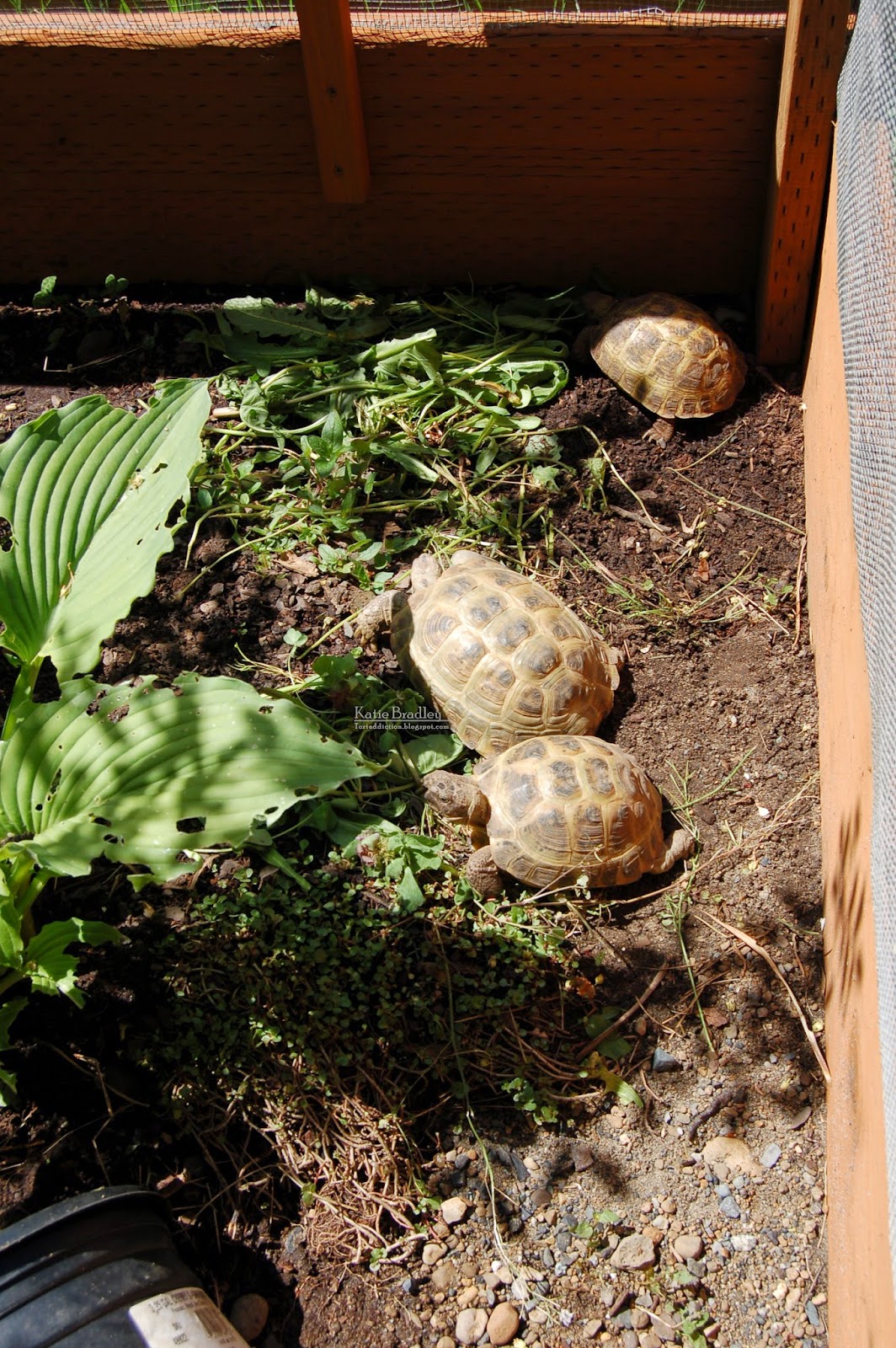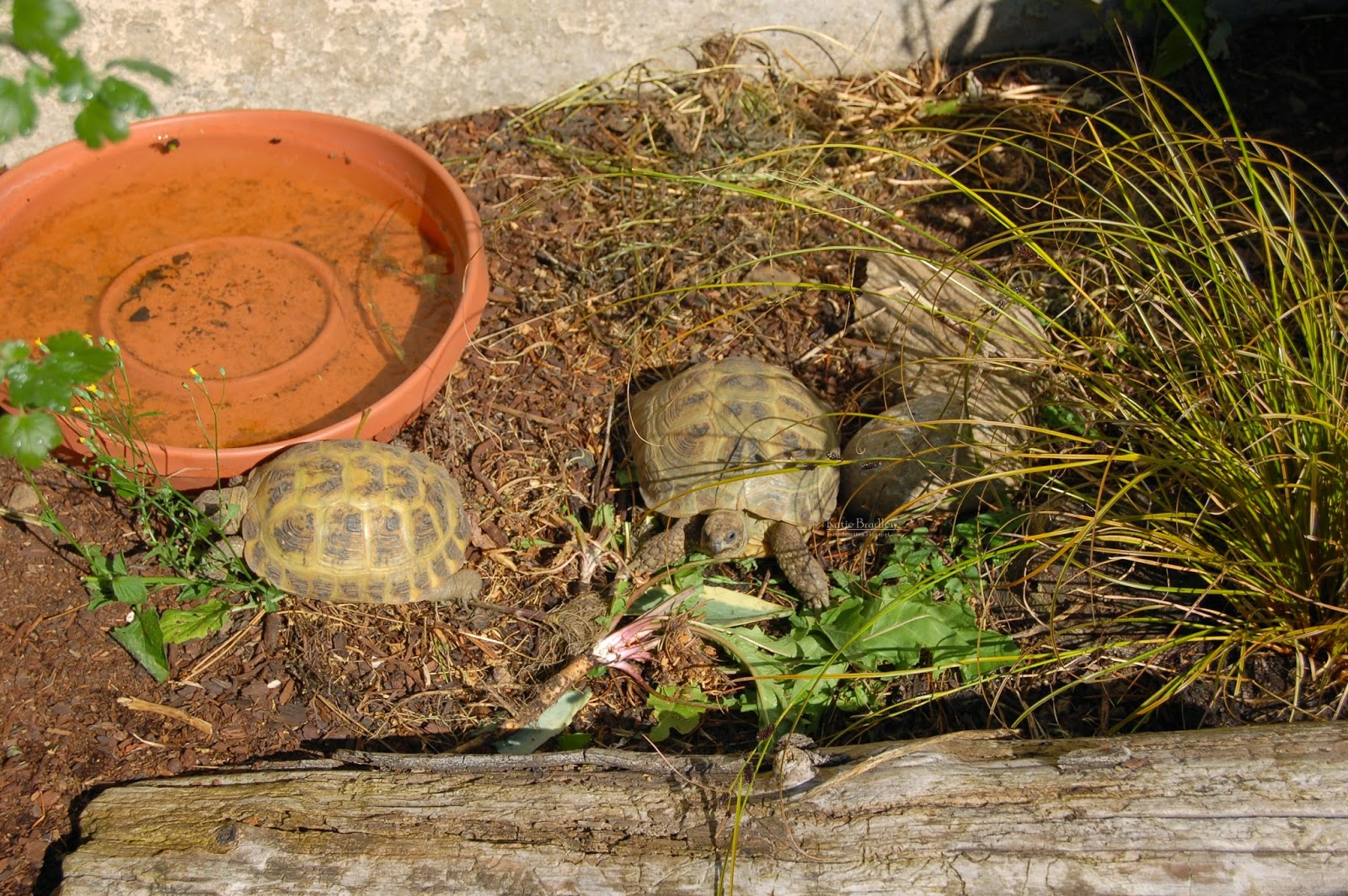Today I would like to show some pictures of my adult Russian tortoises in their outdoor habitat in our yard. My hope is that this will encourage more tortoise keepers to provide their tortoise(s) with an outdoor space.
 |
| Duke, eating weeds while sitting up on a rock - silly boy! |
Keeping tortoises in the Pacific Northwest has a unique set of challenges in that it rains A LOT here for part of the year. However, it is actually possible to keep them outdoors all or most of the time from April through September or even October.
The benefits of keeping tortoises outdoors far outweigh the potential dangers, IF proper precautions are taken and accommodations are made. The natural sunlight provides heat and healthy UVB, which promotes healthy bones and a good hard shell. Being able to wander a much larger area keeps the tortoise's muscles strong. Wild Russian tortoises live in climates that are harsher than ours! They can THRIVE in our climate.
 |
| A morning view of our tortoise yard |
In our climate, moisture can be a problem - Russian tortoises don't seem to mind chilly weather as long as they have the option to stay dry. We solved this problem by building the tortoise yard partially under the eves of our roof - about 2 feet out from our house wall stay completely dry, no matter how hard it rains. I have cut several buckets in half, and buried them under several inches of soil. They provide good hides for the tortoises to burrow into on cool or hot days.
 |
| A morning view of the tortoise yard- it gets much sunnier here in the afternoon! |
Building an outdoor space doesn't have to cost an arm and a leg. I used re-claimed materials off of Craigslist and from my neighbors' left over project lumber. The total cost out of pocket was $35 for this, which was for the decking screws to hold it all together.
I plan to expand the tortoise yard in the next few years, to go further out from the house, as well as going around the corner to the South side of the house. I already have some of the materials for this. I also am scavenging materials to build a little heated greenhouse, which would make it possible for the tortoises to live outdoors for several more months each year!
 |
| Jill and Mila basking in the morning sun |
Russian tortoises are hardy critters, and even when the air temperature is only 60 degrees, the ground temperature in a sunny spot is often 30 degrees higher. You can help this by placing a flat dark-ish rock (or several) into the area the sun hits first in the morning. I've also set up little cold frames (miniature greenhouses), which I built from polycarbonate scraps I scored from a local garden center for a whopping $5 for a stack large enough to make 4.
 |
| Greenhouse made from polycarbonate remnants |
I simply taped the triangles together using foil ducting tape, and ta-daaaa! Instant slightly warmer, dry basking area! These are very simplified versions of a cold frame.
 |
| Amber, hanging out in her pyramid in the quarantine area |
My infrared temperature gun is an important tool - I quickly check the ground temperature in several spots before bringing the tortoises outside in the Spring. In the summer, the ground temperature can actually rise to 140 degrees F on a 90 degree (air temp) day (in that case, it becomes necessary to hose down the tortoise yard to cool it).
 |
I like this one by Etekcity.
I bought it on Amazon, and it has worked for 4 years without needing its battery changed. |
When night temperatures drop below 58 degrees F, I bring the tortoises in at night. Otherwise, they stay outside 24/7 unless it is raining so torrentially that I know the gutters will fail, sending a waterfall over the edge of the roof into the tortoise yard.
The tortoises dig in for the night. Then as soon as the sun hits the tortoise garden (around 11am, since it's on the West side of the house), the tortoises come out to bask in the sunny spots. They wander around, graze, explore, and soak. By afternoon it really bakes out, and they retreat to the shady spots under the bushes. In the evening, they come back out again for another snack, or just to take a walk.
Indoors I have to separate the tortoises into multiple tortoise tables, based on who gets along with whom (or doesn't). Several are permanently in solitary confinement indoors. Outside, there are so many sight barriers, and so much space, that I am able to keep the tortoises together in the large tortoise garden. I keep a close eye on them to make sure nobody is being ganged up on, and I have a 'time out' area set up for them if separation becomes necessary. In the Springtime, the males couldn't be in the same enclosure because they kept fighting. Now they have mellowed.




A different view of the tortoise yard. I have blueberry bushes, gooseberry bushes, and raspberries growing in there. I've limbed up the blueberry bushes to where the tortoises can't reach the fruit or leaves, so they just benefit from the filtered shade. They like to eat the leaves off the raspberry vines, but the fruit is picked by us humans. The gooseberry bush is related to the currant family, so the leaves are safe for the tortoises. We pick the fruit for ourselves. I like that the bushes fulfill a dual purpose - food for us humans, and shade for the tortoises.

I have dug a nice deep trench under the wall of the enclosure, which I filled with cement pavers, so I don't have to worry about the tortoises digging out of their enclosure. My male Roz is an especially avid digger - he makes burrows so deep I have to reach in up to my shoulder to get him out. The walls of the enclosure are capped so the tortoises can't climb out either. Because I am confident the tortoises can't escape, it isn't too scary for me when one of the tortoises disappears for a few weeks for a snooze. I know they are healthy and have had plenty of food, so if the weather is hot or cold, I allow them to burrow down as they see fit.
Lady (the very dirty tortoise shown above and below) disappeared at the end of April, and didn't show up again until last week. She is a big, heavy girl, so I wasn't worried. She came back out and went back to eating as if there had never been a 6-week nap.
I provide water in several flat containers, such as the plant saucer in the picture below. Normally, this container is actually sunken into the ground, but one of the tortoises decided to dig under it, which pushed it up and out.
Some tortoises that are normally picky eaters or have a shy personality really blossom when they are outdoors. Little Jill (who isn't so little anymore!) is a shy picky eater indoors. Outside she eats like a piggy, and even bosses the bigger females around!
I had just hosed down the tortoise yard (including the tortoises) the morning before I took these pictures, hence the tortoises are unusually clean. They normally spend their Summer as grubby little piggies!
Now that it is summer, the tortoise yard has been grazed pretty bare - however, finding healthy weeds is no trouble here in the beautiful, green Pacific Northwest, so the tortoises eat well.
This year was the first year that my tortoises had babies - Timmy and Roz produced 6 beautiful, healthy hatchlings. I am keeping 1 of them, and the others have all been dibsed. Here are a few pictures:
At only about a month old, the babies only spend about an hour per day outside. The baby below is little Duchess (Baby #2), which I am keeping. Eventually I plan to breed her with Duke (our CB male, who is NOT her father) to produce some fine CB2 Russian tortoises in years to come.
Finally, I just have to show off my Amber - she is just shy of 9" long and weighs in at a whopping 1874g. She's a big, big girl! (freshly hosed down in the pic below... I plopped Duke into the pic for size comparison. He's a 5" male).




























Thank you so much for this info. I have two russian tortoises and they have lived outside in the lovely California bay area. We are moving to gig harbor, wa and I was worried about how they can live outdoors but your site is super informative. They love living outside and I really didnt want to have to house them indoors.
ReplyDeleteGig Harbor is lovely! :)
DeleteI would recommend you add an insulated cold frame, with a hound heater and a basking spot. Worth the cost and effort, as it lengthens the outdoor months by about 4 weeks on either end!